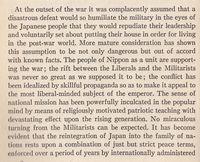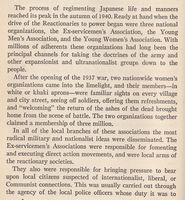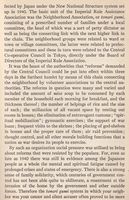
Nippon: The Crime and Punishment of Japan
This is a 1944 book.
The Table of Contents.
The 'crime' of Japan. Basically, the author is saying that Japan adapted the American way of technical production, but did not adapt any of the moral or spiritual concepts such as freedom, respect for the individual, equal rights, etc.
 |
The people were basically brought under total control of those who were in power.
The author notes that other nations linked themselves to some divine lineage, but that was done while the states were still growing; Japan did the same thing, but linked to the past to justify their actions in the present. The Japanese feel their nation is under divine control and protection, never having been successfully invaded.
Basically precognitive words considering what happened to Japan after this book was published.
He's saying that the war should be fought through to the very end, and that if we end up negotiating some kind of peace with Japan before they are utterly defeated then we'll just be postponing another war with that country.
 |
He says that the people of Japan are behind the war, and we will have to win it and set about re-educating the people of Japan.
He's saying that, if Japan was a person, it would be a person with mental illness.
Fear, envy and resentment have all played a role in developing this abnormal psychological outlook.
Anti-white sentiment. The book then goes on to talk about Japanese expansionism throughout history.
Then he talks about the 'traditionalists' which we would call the conservative, right-wing movement today.
The book then goes on to talk about the Japanese economic problems of 1927 and the U.S. stock market crash of 1929 and what effects that had on Japan. Also explored is the opposition to Western influence in Japan. The traditionalists hated the fact that many Japanese were adopting Western modes of dressing, entertainment, and other things. In the 1930's the Japanese did not respond with great enthusiasm over the invasion of China, and there was a problem with the rate of suicides. The growth of Communism was also seen as a threat to Japan.
The author then talks about the death of Liberalism in the Japan of those times. Right-wing organizations really developed quickly in 1932.
Japan ended up a one-party state. The book goes into who was behind that early on. Changes in the Japanese government are covered, along with the various assassinations and coup attempts.
 |
Old books like this one will have information like that that modern books don't. This goes into groups that were sort of a bridge between the nationalist military ideas and the common people.
 |
 |
This is gone into in quite a bit of detail.
All this led to a concept of a 'unity of spirit' in Japan. Basically, it was a system to try and make sure everyone thought the same way and acted the same way. There would be no opposition to anything the government wanted to do. It was a system that was trying to turn the entire civilian population into sheep, basically.
These are the principles of that national unity.
The idea of the entire world under Japan's rule. The book also examines Japanese mythology about the first Emperor.
Basic concepts of the mythology used to justify the actions of the Emperor.
Names that refer to the Emperor.
The Emperor is involved directly in the war effort, he should be held accountable for his actions, and his 'divinity' should be stripped from him.
The book then goes into the Japanese educational system of the time, and how the military and nationalistic concepts are promulgated through the schools.
How a 'thought reform system' was set up for the schools.
The book also goes in to how military training became part of the schools.
After that, he examines the Japanese argument that they needed to expand due to their population problem.
The Japanese view of Shinto.
What the author expected to happen in Japan after the country's defeat.
Main Index
Japan main page
Japanese-American Internment Camps index page
Japan and World War II index page
|
|